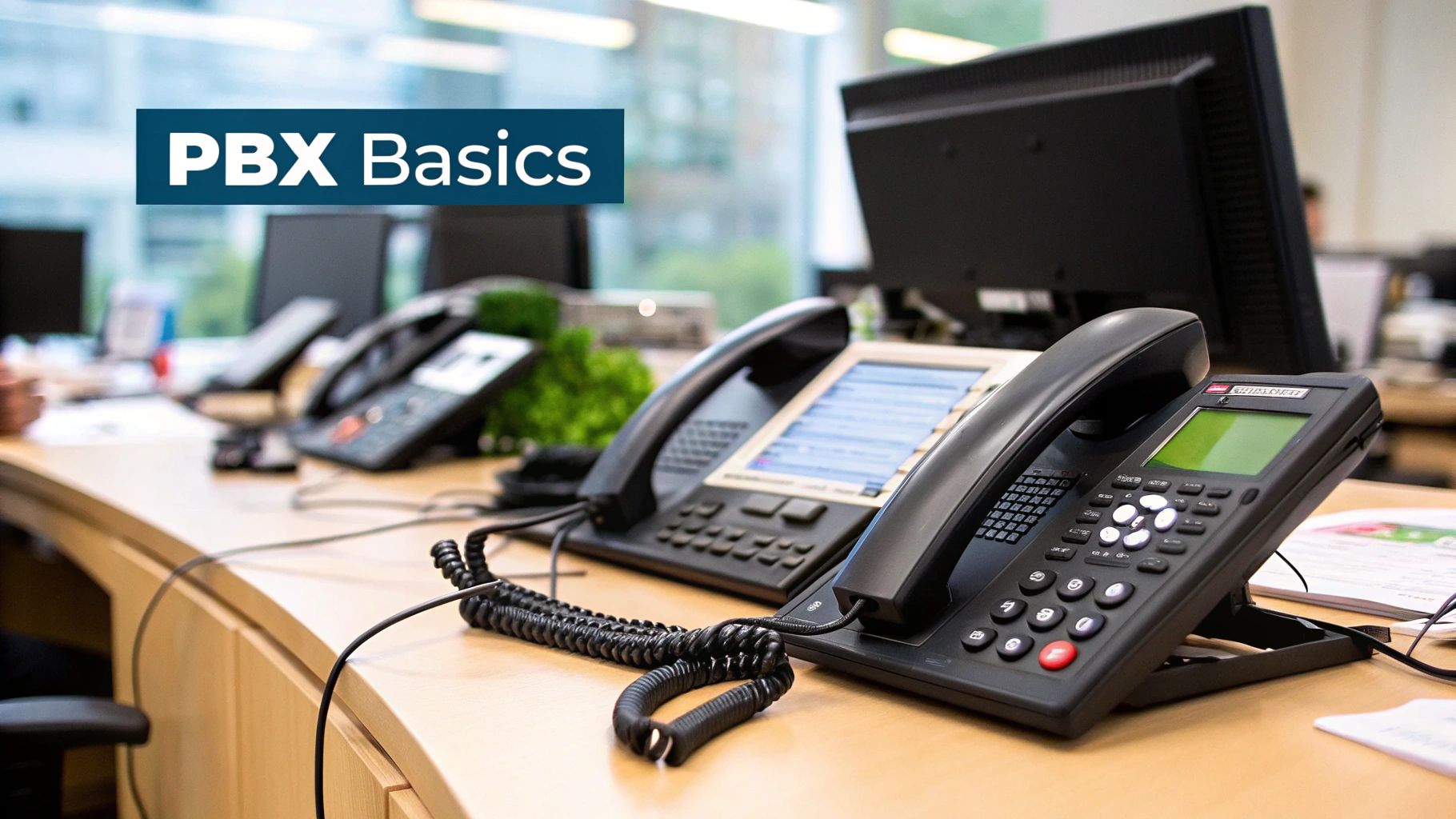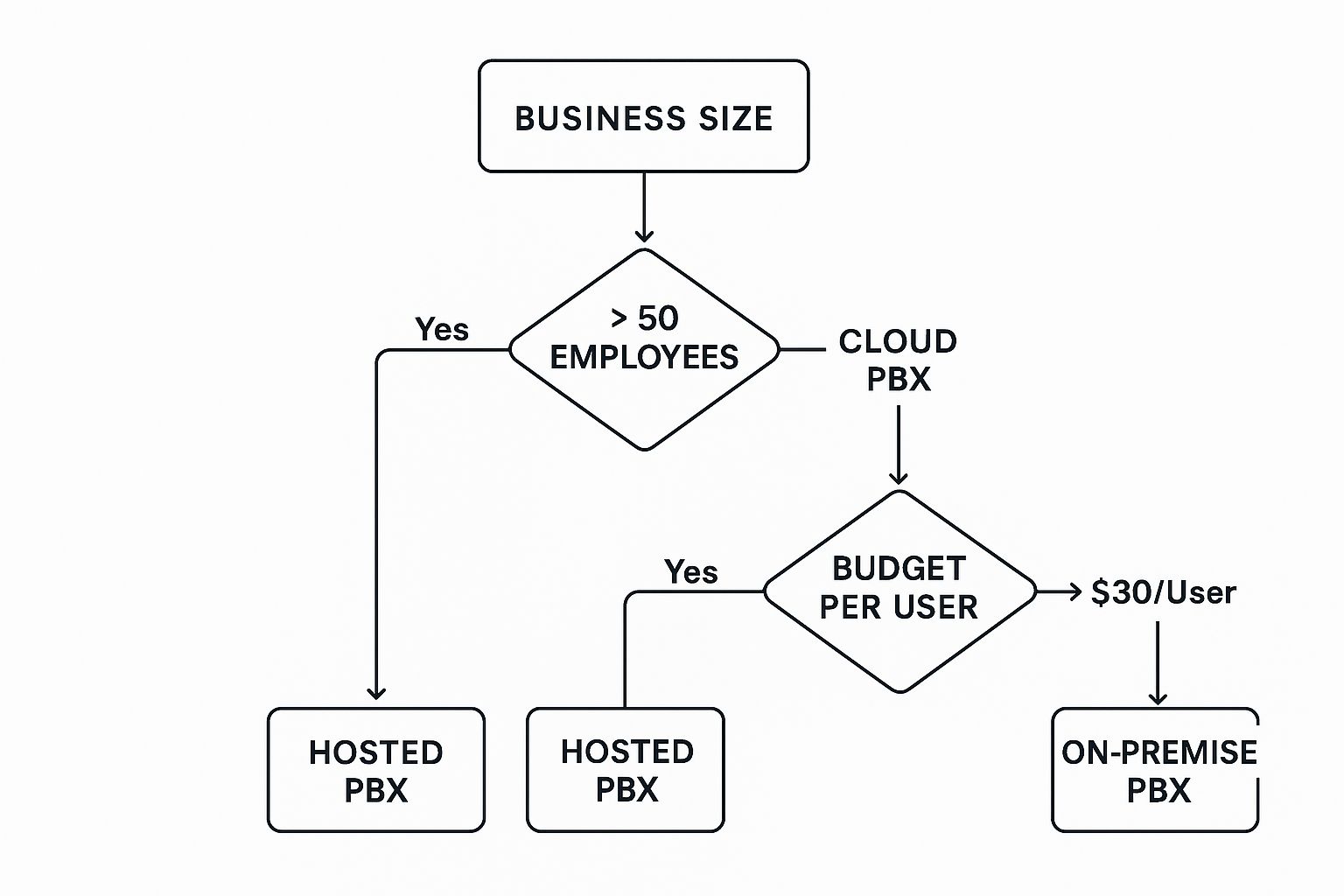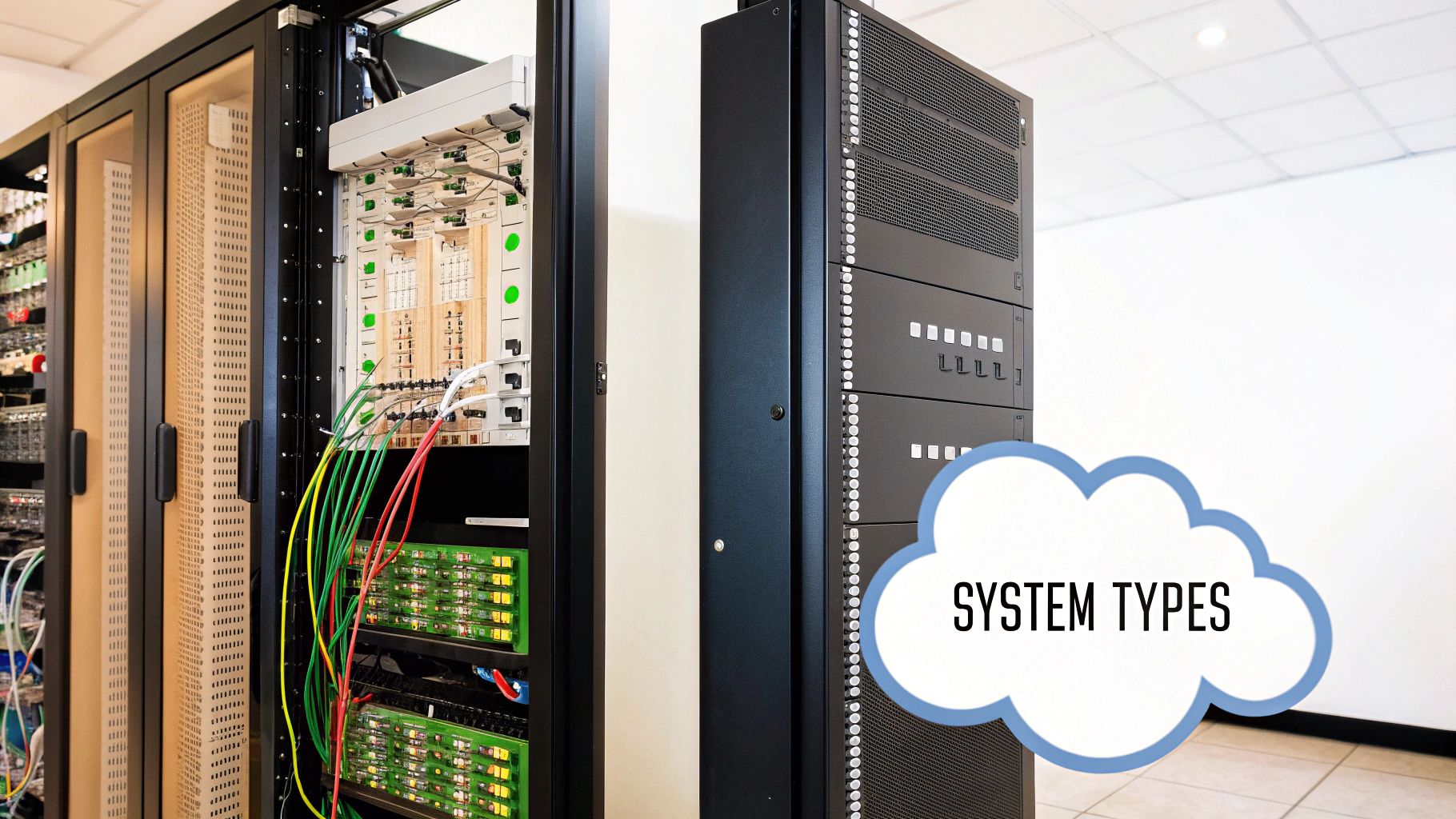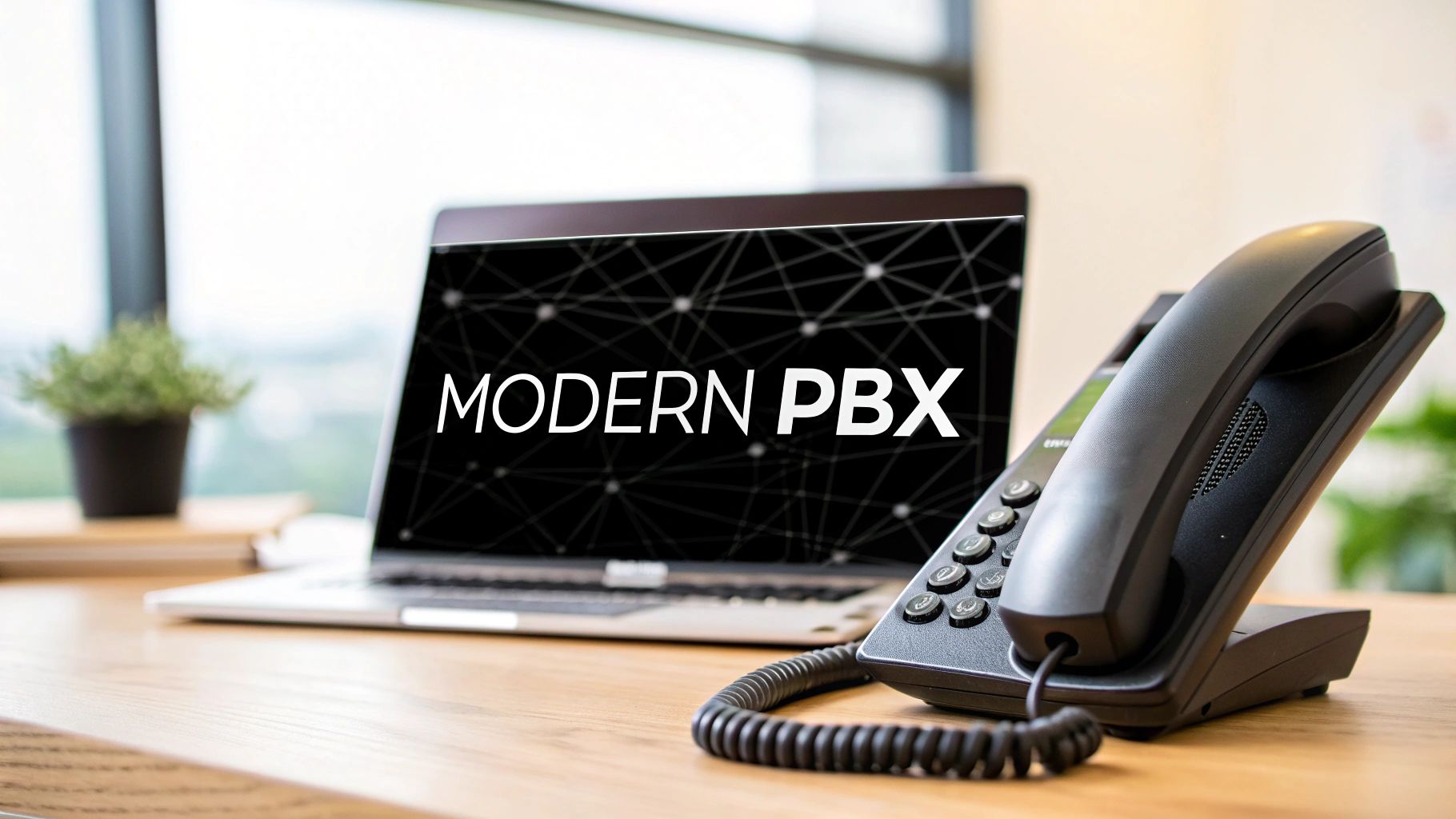At its heart, a PBX telephone system is the private phone network for your company. Think of it as your own internal, highly efficient switchboard. It lets everyone in your organization talk to each other using simple extension numbers, all while sharing a set of outside phone lines. This clever sharing is what drastically cuts down on operational costs.
Modern systems take this a step further by managing calls over the internet, unlocking a whole suite of powerful tools that go far beyond just making and taking calls.
So, What Exactly Is a PBX Telephone System?

Imagine you had an intelligent, automated receptionist working for your company. This receptionist works 24/7, flawlessly directing every single incoming call, connecting team members in an instant, and never taking a break. That's the essence of a Private Branch Exchange (PBX).
A PBX creates a closed, internal phone network just for your business. Instead of paying a public provider for a separate phone line for every single employee, the PBX smartly manages a shared pool of lines. This means any calls between colleagues are completely free.
To put it simply, a PBX is the central nervous system of your business's voice communications. Here's a quick look at what it does and why it matters.
PBX System at a Glance
| Core Function | Business Benefit |
|---|---|
| Internal Call Switching | Enables free, instant calls between employees using extensions. |
| Call Routing & Management | Directs incoming calls to the right person or department automatically. |
| Shared External Lines | Reduces the number of expensive phone lines you need to rent. |
| Advanced Call Features | Provides professional tools like auto-attendants and call queues. |
In short, a PBX streamlines communication, projects a professional image, and saves you money.
From Hardware Closets to the Cloud
Not too long ago, a PBX was a bulky cabinet of hardware humming away in a server room. These original workhorses of corporate telephony relied on complex physical circuits and specialized wiring to switch calls. They got the job done, but they weren't exactly flexible.
Today, the PBX telephone system looks completely different. While those traditional on-premise hardware boxes are still around, most businesses are moving to software-based solutions. These modern PBXs run on servers or, more often than not, live entirely in the cloud, using your internet connection to handle every call.
This leap from physical hardware to software has completely changed the game. It turned the PBX from a simple call-switching box into a true communications hub that seamlessly integrates voice, video, and messaging.
This evolution brings a host of benefits that were once incredibly complex or expensive to achieve with older systems. These advantages are now the bedrock of modern business communication:
- Serious Cost Savings: By sharing a small number of external lines among all users, businesses can slash their monthly phone bills from telecom providers.
- A More Professional Image: Features like an auto-attendant (your digital receptionist), custom on-hold music, and smart call routing make even the smallest business sound like a major enterprise.
- Effortless Scalability: Need to add a phone for a new hire? It's as easy as creating a user profile. This is a world away from the costly and time-consuming physical rewiring that legacy systems demanded. For a closer look at these advanced capabilities, check out what a Yeastar Cloud PBX solution offers.
Choosing Your Path: On-Premise vs. Cloud PBX
Picking the right architecture for your PBX telephone system is one of the most important decisions you'll make for your business communications. It really comes down to a fundamental question: Do you want to own and manage the physical hardware in your office, or would you rather have a provider handle all of that for you in the cloud? This choice between an on-premise and a cloud-based setup will define your costs, maintenance responsibilities, and how easily your system can adapt to change.
An on-premise PBX is the classic approach. Think of it like buying a car. You own the physical hardware—the server and all its related equipment—and it lives right there in your office. This gives you complete, hands-on control over every part of the system, from security rules to custom features. But just like owning a car, you're also on the hook for all the maintenance, repairs, and eventual upgrades.
A cloud PBX, often called a hosted PBX, is much more like using a ride-sharing service. You don’t own the car, but you get all the benefits of getting from A to B. Here, the provider owns and manages all the complex hardware in their secure data centers. You simply connect to your phone service over the internet and pay a predictable monthly fee. This model effectively outsources all the technical headaches.
The On-Premise Model: Ownership and Control
With an on-premise PBX, your main investment is at the beginning. You'll need to buy the server and possibly new IP phones, which can be a significant capital expense. While your ongoing costs are generally lower, you absolutely have to budget for your IT team's time to handle maintenance, software updates, and any troubleshooting that comes up.
The real draw here is total autonomy. You control your security destiny, decide exactly when and how to upgrade, and can integrate the system deeply with other on-site technology without depending on an outside vendor.
This path is often the best fit for larger organizations or companies with very specific, strict security needs and an IT department that's ready and able to manage the system.
The Cloud Model: Flexibility and Simplicity
A cloud PBX completely flips the cost structure. The upfront investment is minimal—often just the price of new IP phones, if your old ones aren't compatible. Instead, you pay a monthly subscription fee, typically on a per-user basis. This fee bundles in all the system maintenance, security, and feature updates, which the provider handles for you automatically.
This approach offers incredible scalability. Need to add a new employee or remove one? It’s usually just a quick support request or a few clicks in a web dashboard. This makes it perfect for growing businesses or those with seasonal staffing changes. The move toward hosted solutions is undeniable. For instance, the Middle East and Africa (MEA) hosted PBX market generated over USD 1.08 billion in revenue and is expected to grow at a CAGR of 16.3% through 2030, showing just how fast the trend is catching on.
This decision tree can help you see which path might make more sense based on your business size and budget.

As the infographic shows, while big companies might go with cloud options for scale, smaller businesses often make the call based on their budget per user, weighing the pros and cons of long-term ownership versus immediate flexibility. To really dig into your options, it's worth exploring the wider debate of cloud server vs. in-house hosting, as the core ideas apply directly to choosing a PBX.
Unlocking Powerful Communication Features

Today’s PBX is much more than a simple internal switchboard. It's a comprehensive communication hub designed to make your team more productive and your customers happier. These systems are loaded with tools that handle routine tasks automatically, give you deep insights into your operations, and help your team connect in smarter ways.
Once you see what these features can do, you'll understand how a PBX telephone system goes beyond just making and taking calls. It becomes a real strategic advantage for your business.
A great starting point is the Auto-Attendant. Think of it as a virtual receptionist who never sleeps. It answers every single call with a professional, custom greeting and gives callers a clear menu of options, like "Press 1 for Sales, Press 2 for Support." This simple feature gets callers to the right person or department right away, no human effort needed. It makes you look polished and professional, no matter how big or small your company is.
Intelligent Call Handling and Routing
After that first greeting, a PBX really shines with its intelligent Call Routing. This is the brain behind the system, deciding exactly where each call should go based on rules you set up. You can direct calls based on the time of day, who's calling, or even set up sophisticated queues that keep callers on the line with music or updates until an agent is free.
This means you never miss a call. For example, any call coming in after hours can be sent straight to voicemail. A call from a VIP client? It can be routed directly to their dedicated account manager's extension. This level of control is key to providing a consistently great customer experience. To get a better handle on a core feature that drives these menus, it's worth understanding what IVR is and its role in automated systems.
Advanced Capabilities for Modern Business
What truly sets a modern PBX apart are its advanced tools for integration and data analysis. These are the capabilities that turn a good phone system into an indispensable business tool.
-
Voicemail-to-Email: This handy feature takes any voice message, converts it into an audio file, and pops it right into your email inbox. You can listen to messages on your phone or laptop, forward them to a colleague for follow-up, and keep a neat archive of everything without ever picking up a desk phone.
-
CRM Integration: This is an absolute game-changer for any sales or customer service team. When a customer calls, the PBX talks to your Customer Relationship Management (CRM) software. Instantly, the caller's complete profile—contact info, past purchases, previous support tickets—appears on your agent's screen.
By connecting your PBX to your CRM, you give your team the context they need to excel. An agent can greet a customer by name and already know their history, which leads to quicker solutions and the kind of personal touch that builds serious customer loyalty.
- Detailed Call Analytics: A modern PBX telephone system is a goldmine of data. It tracks everything. Managers can pull up reports and dashboards showing crucial metrics like call volume, peak business hours, average wait times, and even individual agent performance. This information is pure gold for figuring out staffing, spotting training opportunities, and making smart decisions to run a tighter ship.
These features, and many others, completely change the way a business communicates. If you're looking for a solid, feature-packed solution, exploring what's possible with a modern PBX IP phone system will show you just how much room there is to improve your daily operations.
The Real Business Impact of a PBX System
It's one thing to understand the technical side of a PBX telephone system, but the real question is what it can actually do for your business. When you look past the technology itself, you’ll find a smart investment that pays off in three major ways: cutting costs, boosting your professional image, and making your operations far more flexible.
The first thing most businesses notice is a serious drop in their phone bills. A PBX gets rid of the need for an expensive, dedicated phone line for every single employee. Instead, it lets everyone share a few external lines, and any calls made between colleagues are completely free.
This simple change means your monthly telecom expenses go down, giving you a much more predictable budget. The savings don't stop there, either. Modern systems also cut down on the need for costly maintenance visits from specialized technicians.
Projecting a Polished Corporate Image
The way your business answers the phone speaks volumes. A PBX system gives you the tools to sound like a major corporation, even if you're just starting out.
Features like a custom auto-attendant ("Welcome to our company, press 1 for sales…") and professional on-hold music make your business sound organized and established. Smart call routing also makes sure customers get to the right person on the first try, which cuts down on frustration and creates a great first impression.
A PBX telephone system transforms your communications from a simple utility into a powerful tool for building customer confidence and projecting a first-class professional image, regardless of your company's size.
Achieving Unmatched Scalability and Productivity
Perhaps the most powerful long-term benefit is how easily a PBX can grow with you. A modern system, especially a cloud-based one, is built for expansion. Adding a line for a new team member takes just minutes through a web portal, a huge advantage for any growing company. It’s a world away from the slow and expensive process of installing new physical wiring.
This flexibility also means your team isn't chained to their desks anymore. Key features that boost productivity include:
- Remote Extensions: An employee can use a softphone on their laptop or a mobile app to make and receive calls on their office number from anywhere with an internet connection.
- Unified Communications: Bringing voice, chat, and video together on a single platform keeps everyone connected and working together, whether they’re in the office or across the globe.
- Seamless Growth: The system can handle more calls and more users as your business expands, all without needing a massive hardware upgrade.
This combination of savings, professionalism, and flexibility is why these systems are being adopted so quickly around the world. The global PBX market is currently valued at USD 44.26 billion and is expected to climb to USD 124.54 billion by 2035. This trend is particularly strong in the MEA region, where small and medium-sized businesses are using these systems to support their growth. You can explore more about the global PBX market's impressive growth on Future Market Insights.
Ultimately, getting a PBX isn't just a tech upgrade; it’s a strategic decision that positions your business for greater efficiency and long-term success.
How to Select the Right PBX Provider

Choosing the right provider for your PBX telephone system is one of those crucial decisions that will ripple through your entire organization. It directly affects your day-to-day communication, your budget, and even your ability to scale. With so many vendors vying for your attention, it's easy to get lost. The key is to take a step back and start with a clear, honest look at what your business actually needs.
Before you even glance at a sales brochure, you need to map out your own operational landscape. How many people in your company need a phone line right now? What about a year from now? Think about your call volume—not just the daily average, but what it looks like during your absolute busiest moments. Getting these numbers down first will help you gauge the scale of the system you're shopping for.
Defining Your Must-Have Features
With your core requirements in hand, it's time to create a "must-have" feature list. This isn't about shiny objects; it's about real-world impact. Does your business need advanced call recording for compliance or to help train new team members? Is it an absolute deal-breaker if the phone system can't talk to your existing CRM, like Salesforce or Zoho?
Think about where specific features will give you a genuine advantage. For example, here in the United Arab Emirates, businesses in the fast-moving finance and real estate industries are flocking to cloud PBX systems. They’re using them to sharpen customer engagement and become more agile. The country’s top-tier digital infrastructure makes these flexible, feature-rich solutions a smart strategic move. You can discover more about the cloud PBX market trends in the UAE to see exactly how local companies are leveraging this technology.
Key Criteria for Evaluating Providers
Once you have your checklist, you can start sizing up potential providers. But don't just stop at the feature list. You need to dig deeper into the fundamentals that make or break a business phone system.
The most incredible features on paper are completely worthless if your phones are always down. Your top priority should be finding a provider who guarantees high uptime and has a support team that actually picks up the phone when you need them.
To cut through the sales pitches and get to the heart of what matters, here are the critical questions to ask every single vendor you consider:
- Reliability and Uptime: What is your service level agreement (SLA) for uptime, and is it guaranteed? Look for a provider that promises at least 99.9% uptime. Anything less is a red flag.
- Customer Support: When things go wrong, what does support look like? Ask about their hours, their support channels, and whether you get 24/7 access to a live person for critical problems.
- Security Protocols: How are you protecting my calls and my data? You want to hear specifics about call encryption, secure data centers, and how they comply with local regulations.
- Technology and Scalability: Is the system built on modern, future-proof technology? A little background reading, like our guide about what SIP is, can empower you to ask smarter questions about the underlying architecture.
- Pricing and Contracts: Can you show me a completely transparent breakdown of all costs? Make sure you understand every potential fee—from setup and per-user charges to contract length—so there are no nasty surprises down the road.
Using this structured approach, you can move beyond the marketing hype. It allows you to systematically compare your options and confidently choose a PBX partner that truly aligns with your budget, your operational workflow, and your vision for the future.
Got Questions About PBX? We've Got Answers.
Even after you get the basic idea of what a PBX phone system can do, a few questions usually pop up. The technology has its own language, and some of the concepts can feel a bit tangled at first. Let's clear up some of the most common points of confusion so you can move forward with confidence.
We’ll dig into the key differences between related technologies, what kind of hardware you actually need, and how secure these systems really are.
What Is the Difference Between PBX and VoIP?
This is, without a doubt, the question we hear most often. The confusion is completely understandable because the two are deeply connected, but they aren't the same thing.
Think of it like this: VoIP (Voice over Internet Protocol) is the engine that powers the car. It's the core technology that turns your voice into digital data and sends it over the internet. The PBX, on the other hand, is the entire car itself—the dashboard, the steering wheel, the GPS, and all the controls. It's the complete system that manages where calls go, connects extensions, and gives you all the smart business features you need.
A modern PBX simply uses VoIP to do its job. VoIP is the how—the transmission method. The PBX is the what—the full-featured command center for all your business calls.
Do I Need Special Phones for a PBX System?
That depends entirely on which type of PBX you go with. If you're looking at an old-school, on-premise system, you'll often need specific IP desk phones designed to work only with that brand of PBX hardware.
This is where a modern cloud PBX really shines. It gives you incredible flexibility in how your team connects. You can mix and match based on what works best for each person.
- IP Desk Phones: For a classic office setup, you can still use dedicated, internet-ready desk phones.
- Softphones: Your team can install a "softphone" app on their laptops or desktops. Paired with a headset, their computer becomes a powerful business phone.
- Mobile Apps: Most providers offer slick mobile apps that let your staff make and take calls from their business number, right on their personal smartphone.
This freedom means you can equip your team based on their actual role and work habits, whether they're at a desk, working from home, or constantly on the move.
Is a Modern PBX System Secure?
Any tool that handles your business communications has to be secure, and this is an area where reputable PBX providers invest heavily. A good cloud PBX vendor provides enterprise-grade security that’s often far more robust than what a small or medium-sized business could afford to build on its own.
Look for providers that offer multiple layers of protection, including:
- Call Encryption: Using protocols like SRTP and TLS to scramble call data and prevent anyone from listening in.
- Secure Data Centers: Housing all the core infrastructure in facilities with top-tier physical security, network monitoring, and redundancy.
- Fraud Detection: Using sophisticated systems to monitor for strange call patterns and block toll fraud before it becomes a problem.
Remember, if you choose an on-premise system, all of that security responsibility lands squarely on your shoulders. When you're evaluating providers, don't be shy—ask them for details on their security protocols and compliance certifications.
How Difficult Is It to Set Up a Cloud PBX?
One of the most compelling reasons businesses switch to a cloud PBX is how ridiculously easy it is to get started. Because there’s no massive server to install in your office closet, the provider has already done almost all of the heavy lifting.
Your part of the process is surprisingly simple. It usually just involves logging into a web portal to configure your settings and then plugging in your new IP phones or having your team install the softphone app. We’re talking about a process that can be completed in days, not the weeks of disruption and technical work it took to roll out a traditional on-premise system.
Ready to transform your business communications with a powerful, secure, and flexible solution? Cloud Move offers tailored unified communications that scale with your needs, from cloud to on-premise deployments. Integrate with your CRM, engage customers across every channel, and benefit from crystal-clear voice quality and 24/7 support. Revolutionise your customer engagement and book a free demo at https://cloud-call-center.ae.




